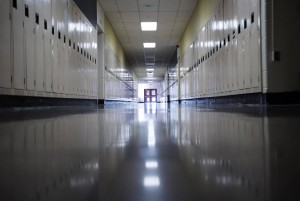Optional attendance kills Vaughan Road Academy
 Race and class key to school’s demise.
Race and class key to school’s demise.
How odd it is to walk down these empty hallways. For the past 30 years, I’ve only visited them in dreams – and nightmares.
Vaughan Road Academy, my old high school, is dying. In a month’s time it will be dead, the victim of declining enrolment (there are 200 students in a school that could hold five times that number.) Its demise can be attributed, depending on who you ask, to changing demographics, neoliberal forces in public education, racial and class divisions or the school’s failure to adapt to a city that constantly shapeshifts around it. In any case, dead at the age of 90. Causes of death: various.
The school is located in a neighbourhood lacking famous landmarks, unless you count the junction of Vaughan Road and Oakwood Avenue. One afternoon, I walk through the freshly painted front doors, turn left, then right – the school was built over the years in the shape of a triangle – and enter the cafeteria, also freshly painted. The piano was recently tuned. This flurry of effort suggests makeup applied to the face of a corpse, a bit of lipstick and blush so the mourners won’t be frightened.
The final commencement ceremony isn’t until June 23, but there will be a wake (officially a celebration) for the school today. Some of its most famous alumni may even show up – the actors and writers and Nobel winners, possibly even Drake, although this is whispered without much hope. Imagine what a party it would be if Drizzy showed up, five years after he finally graduated, at 25, from the school’s Interact program for elite performers and athletes. The school could die happy.
Ten days before the farewell party, Vaughan is as quiet as a graveyard. It’s 4 p.m. In my day, in the eighties, the hallways would have been crammed with girls in Cyndi Lauper ponytails and boys armoured in layers of Polo cologne. Each of us shouting, listening to a Walkman, heading off to band or football or drama or yearbook or to have a smoke by the smokestack or make out in the parking lot. There would have been life – too much of it, sometimes, when you were 16.
You could reliably call “Tony!” or “Maria!” down the hall and see half the kids turn. The little houses that fed the school were filled mostly with working-class Italian families who had not yet escaped to Maple or Woodbridge. There were also some Greeks and Portuguese, quite a few kids whose parents had come from the Caribbean, plus a smattering of Chinese and Jewish kids. That ethnic profile would change over the next 30 years. The city changed, too, along with our ideas about educating our children.
I highly recommend a visit to your old high school; it is worth at least five trips to the therapist’s office. Memories return unbidden: I got stoned in that stairwell, and in that classroom the geography teacher told me I was going to hell in a handcart. He was right, of course, although at the time I had to look up what handcart meant.
There were about 1,000 students in my day. The 200 who are there now all have to go to new schools next year, except, of course, for the ones who are graduating. The school suffered from empty-restaurant syndrome: How often have you walked past a restaurant and, seeing no one in it, hurried along? We are human. We want to be part of the pack. More to the point, we want our children to be part of the pack – preferably at the head.
When my brothers and sister and I attended, the school was called Vaughan Road Collegiate Institute – and it was pretty damned impressive, with a swimming pool, two gyms and a 700-seat auditorium (where I spent most of my five years, writing and acting in plays). In the 1970s, the school was so full that portables filled the parking lot. But by the late 1980s, with the extension of public funding to Catholic high schools, enrolment at Vaughan dropped.
The neighbourhood, now known as Oakwood Village, changed and developed a bad reputation (the average household income is $46,000, slightly below the city average of $52,000, but, like all parts of the city, it’s gentrifying). “It’s rough,” people would whisper about the area. “Sketchy.” These were code words for things Torontonians were too racially sensitive to say. But you can’t talk about what’s happening to Vaughan Road Academy and, by extension, other community schools in low-income neighbourhoods without talking about race and class.
“You used to hear that people would say, ‘It’s a black school,’” said Elizabeth Cinello, a Vaughan alumnus who is part of the neighbourhood group that fought hard to keep the school open. (The Toronto District School Board announced the school would close in December, 2016, although the building will be kept as a core asset and, with hope, will be turned into a community hub.)
For Ms. Cinello, the issue of “optional attendance,” which lets high-school students choose far-off schools for their specialized programming, creates two-tier education that pushes low-income kids further to the margins. Even if their kids are accepted at a specialized arts, math or business high school, financially strapped parents usually can’t afford to drive them across town or pay for transit. When better-off kids choose a boutique program across town, the local school loses numbers, then funding. Finally, it cuts its programming, which means it can’t attract new students. “It’s a death spiral,” Ms. Cinello said.
Vaughan did try to change. It sprouted fancy new petals to tantalize new learner bees. As the number of young children in the neighbourhood dropped, the school tried to extend its reach across the city. In 1985, it launched Interact, the program that produced Drake, Ellen Page and Sarah Gadon. In 1997, the school got a full-body makeover and became Vaughan Road Academy. Now it had uniforms and, more important, the International Baccalaureate program.
That program “was meant to capture Jewish kids from Cedarvale,” said Jason Kunin, who has taught at Vaughan for 17 years. (Cedarvale is the affluent neighbourhood directly northeast of the school.) Mr. Kunin thought the first couple of years of the IB program were alarming: “It was like apartheid. You’d walk into the IB program and it was 90-per-cent white. You’d walk into the mainstream classrooms and it was the rest of the world.”
That has changed, he said, with the streams becoming more heterogeneous. But Mr. Kunin, who is busy making videos for Vaughan’s farewell, is worried about the long-term effects of parents trying to get their kids into a handful of oversubscribed schools: “It’s not bringing us together. It’s tearing us apart. It’s isolating us into class and race silos.”
Last October, the York Guardian community newspaper situated the issue bluntly under a headline that read: “Racial segregation blamed for possible closure of Vaughan Road Academy.” The story revealed the rising tensions at a community meeting where one parent claimed the closing “had nothing to do with programming, but everything to do with race and class.” Another parent shot back: “I resent the insinuation.” (I wasn’t there, but it seems like the most Toronto meeting imaginable. I can hear the conversation chasing its tail long into the night: “We just want to send our kids to the best school. … Yeah, well, so do I!”)
These tensions have not escaped the view of Vaughan’s students, few though they are. “A lot of kids in more affluent areas gravitate toward Forest Hill or Northern [Secondary School] because they see those as schools where more affluent kids go,” said Drew Barot, 17, a Grade 12 student and president of the student council at Vaughan.
It’s fair to say Drew loves Vaughan. He loves it so much that he commutes an hour and 25 minutes each way to school from his home in Thornhill. It’s also fair to say he is more successful academically than I ever was: He just placed second in an international business competition for high-school students and he’s now deciding whether to go to the London School of Economics or the Ivey Business School at the University of Western Ontario.
The thing he likes – that everyone at the school likes, suggesting the camaraderie of a lifeboat – is that proximity has fostered affection. The dozen teachers are close to the kids. “They really go the extra mile for us,” Drew said. The teachers feel they are in the big-city equivalent of a one-room schoolhouse: “It’s like a little village here,” Mr. Kunin said. “When I come to work, I don’t feel like I’m just teaching. I feel like I’m giving back to the community.”
I recognize that feeling. There were teachers at Vaughan who changed me and who I will never forget. As I walk the quiet corridors, I can see them standing at the front of the empty classrooms. Mr. Cameron, who loved Shakespeare and did not cringe at our pronunciation. Mrs. Allen, who taught us history but more importantly treated us like adults and opened our minds. One day, I’m talking to my high-school friend Tony, and he reminds me that once we’d been drinking wine before history class. Mrs. Allen, instead of suspending us, wrinkled her nose and said: “If you’re going to show up drunk in my classroom, at least open the windows.”
I’d forgotten that. Maybe I drank more than I remembered. Or maybe it was just too much, those years, too much of everything. The memories are dark and light, clouds across the sun. I remember feeling like an outsider, but also moments of belonging that were almost painfully intense. I ask Tony: “Were we happy then? Do you even remember?” He sighs. “I don’t know. Maybe some days. I was a walking Morrissey song.”
I wander through the empty halls, seeing things I’d never noticed. Why had I never known that I had gone to the same school as Al Waxman and a couple of Nobel laureates? How had I never noticed that, among the dozens of alumni who had died in the Second World War, one was a woman?
And finally, I learn the school’s motto, In Medium Quaesita Reponunt, which translates as: “Through study they restore community.” Given the death knell in the distance, that seems more like a rebuke than a lesson.


